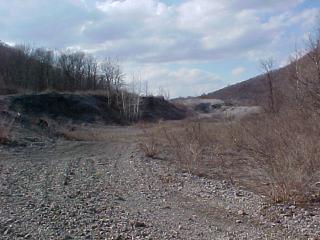
Entrance to the Cinder Dumps
Not a whole lot of detail is really known about the Earlston Furnace. The mass majority of what is known, comes from the research and excellent local books written by Jon Baughman.
While there are plenty of remnants of the Earlston Furnace itself on the property where the Turnpike Detail of the PA State Police/Everett Maintenance shed now stands, I will for now focus on the area commonly referred to locally as "The Cinder Dumps".
From what I understand of the process of refining iron ore, this was basically the dumping grounds for the useless by-products of the melting down of the ore to make pig iron. While there really isn't a whole lot to see, there are a few somewhat hidden historical gems. This, along with the fact that this was a virtual playground for myself and many other Everett youth growing up past and present, prompted me to make a little page dedicated to this area.
First, a brief history of the Earlston Furnace.
It all started in the early 1880's, when plans were underway by several area businessmen of the time to construct an iron furnace in the Everett area. The furnace was finally completed and put into operation on Dec. 10, 1884, as the "Everett Iron Company". Along with the furnace, coke ovens in Kearney, PA, were part of the operation, as well as a small railroad, that was constructed to reach the ore deposits in various places along Warrior's Ridge out the Black Valley road.
The business didn't fare very well, mostly due to the poor quality of ore obtained from Warrior's Ridge, and thus, the business was sold in 1887 to Joseph Thropp, who rekindled the business by importing better ore from the Great Lakes region. It was renamed the "Earlston Furnace", as Earlston was not only his middle name, but also the name of one of his sons.
Thropp built somewhat of a small empire of his business, and an entire community was built around it. It is commonly known that a majority of the houses you see as you first cross the west end bridge in Everett and make the first right, were built by and for the employees of the Earlston Furnace, along with several of the houses on the way to Ashcom. The former company store, locally still known as "Sonny Dicken's Store", stills stands today, the second structure on the left as you cross the bridge. According to records and stories, Thropp took good care of his employees, even finding other ways to keep them fed during periods when running the furnace wasn't profitable, such as gardening. It is said that a great deal of the area occupied presently by the housing development known as "The Foor Addition", was covered by these gardens.
Sadly, it couldn't last forever. With steel already the main metal in the country in place of iron, the company continually lost money, until operations ceased, and the company was auctioned off in 1925. Another party bought the Earlston Furnace and ran it a few times up until 1929, when it was auctioned off for the last time, and most main parts of the furnace scrapped.
Thropp also owned and operated the quarry in Ashcom, now owned by the New Enterprise Stone and Lime Company. It has been said by some locals that NESL also acquired the Cinder Dumps area when they purchased the quarry, and experimented with using the leftover slag as filler material in their highway production materials, most notably, for the building of the four-lane between Everett and Breezewood.
Eventually, I plan to include photos of all aspects of the Earlston Furnace operation, provided I can get the proper permissions to photograph various locations. But for now, it will only include the "Cinder Dumps".